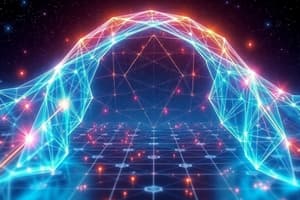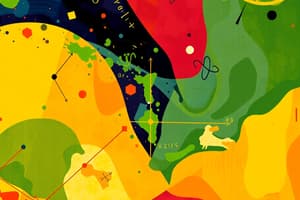Podcast
Questions and Answers
Which of the following best describes the relationship between pure and applied mathematics?
Which of the following best describes the relationship between pure and applied mathematics?
- Pure mathematics deals with abstract concepts, while applied mathematics uses mathematical tools to solve real-world problems. (correct)
- Pure mathematics and applied mathematics are synonymous terms referring to the same field of study.
- Applied mathematics is a prerequisite for pure mathematics, as real-world problems must be solved before abstract concepts can be developed.
- Pure mathematics focuses on practical applications, while applied mathematics is concerned with abstract concepts.
Which branch of mathematics focuses primarily on the properties of integers?
Which branch of mathematics focuses primarily on the properties of integers?
- Geometry
- Topology
- Calculus
- Number Theory (correct)
Which of the following reflects the role of axioms in mathematical proofs?
Which of the following reflects the role of axioms in mathematical proofs?
- Axioms are assumed to be true without proof and serve as the foundation for proving theorems. (correct)
- Axioms are only used in applied mathematics, not in pure mathematics.
- Axioms are conjectures that have not yet been proven.
- Axioms are proven statements used to derive new theorems.
Which list below correctly orders the number types from least to most inclusive?
Which list below correctly orders the number types from least to most inclusive?
In the context of mathematics, what is the primary purpose of a mathematical model?
In the context of mathematics, what is the primary purpose of a mathematical model?
Which field of mathematics deals with the study of continuous deformations, such as stretching and bending, without tearing or gluing?
Which field of mathematics deals with the study of continuous deformations, such as stretching and bending, without tearing or gluing?
Which mathematical concept is most applicable when analyzing the rate of decay of a radioactive substance?
Which mathematical concept is most applicable when analyzing the rate of decay of a radioactive substance?
If you are trying to determine the number of ways you can arrange 10 books on a shelf, which area of mathematics would you most likely use?
If you are trying to determine the number of ways you can arrange 10 books on a shelf, which area of mathematics would you most likely use?
Which of the following is an example of how mathematics is applied in finance?
Which of the following is an example of how mathematics is applied in finance?
Which statement best illustrates the evolving nature of mathematical notation?
Which statement best illustrates the evolving nature of mathematical notation?
Which of the following statements accurately describes the relationship between theorems and proofs?
Which of the following statements accurately describes the relationship between theorems and proofs?
Which area of mathematics would be most useful in determining the optimal layout of components on a circuit board?
Which area of mathematics would be most useful in determining the optimal layout of components on a circuit board?
What role does mathematics play in the field of medicine?
What role does mathematics play in the field of medicine?
Which is the key focus of mathematical research?
Which is the key focus of mathematical research?
Which of the following represents a real-world application of differential equations?
Which of the following represents a real-world application of differential equations?
How do mathematical societies, such as the American Mathematical Society, contribute to the field of mathematics?
How do mathematical societies, such as the American Mathematical Society, contribute to the field of mathematics?
Which of the following statements accurately describes the role of mathematical problem-solving?
Which of the following statements accurately describes the role of mathematical problem-solving?
Which of the following is a common application of trigonometry?
Which of the following is a common application of trigonometry?
What distinguishes mathematics from other sciences?
What distinguishes mathematics from other sciences?
The concept of infinity is essential to which branch of mathematics?
The concept of infinity is essential to which branch of mathematics?
Flashcards
What is Mathematics?
What is Mathematics?
The abstract science of number, quantity, and space.
What are Axioms?
What are Axioms?
Statements or propositions that are believed to be true, often used as a basis for establishing or accepting truth of something else.
What is a Theorem?
What is a Theorem?
A statement that has been proven to be true based on axioms and previously established theorems.
What is a Proof?
What is a Proof?
Signup and view all the flashcards
What is Research?
What is Research?
Signup and view all the flashcards
What is Applied Mathematics?
What is Applied Mathematics?
Signup and view all the flashcards
What is Pure Mathematics?
What is Pure Mathematics?
Signup and view all the flashcards
What is Arithmetic?
What is Arithmetic?
Signup and view all the flashcards
What is Algebra?
What is Algebra?
Signup and view all the flashcards
What is Geometry?
What is Geometry?
Signup and view all the flashcards
What is Trigonometry?
What is Trigonometry?
Signup and view all the flashcards
What is Statistics?
What is Statistics?
Signup and view all the flashcards
What is Topology?
What is Topology?
Signup and view all the flashcards
What is Number Theory?
What is Number Theory?
Signup and view all the flashcards
What is Combinatorics?
What is Combinatorics?
Signup and view all the flashcards
What is a Mathematical Model?
What is a Mathematical Model?
Signup and view all the flashcards
What is Change?
What is Change?
Signup and view all the flashcards
What is Structure?
What is Structure?
Signup and view all the flashcards
What is Infinity?
What is Infinity?
Signup and view all the flashcards
Study Notes
- Mathematics is the abstract science of number, quantity, and space.
- Mathematics may be defined as the subject in which we never know what we are talking about, nor whether what we are saying is true.
- It seeks out patterns and formulates new conjectures.
- Mathematicians resolve the truth or falsity of conjectures by mathematical proofs.
- Mathematical proofs use mathematical reasoning to establish statements.
- Mathematical research outputs consist of: conjectures, proofs, and mathematical models.
- Mathematics is essential in many fields, including natural science, engineering, medicine, finance, and social sciences.
- Applied mathematics concerns itself with the use of mathematical tools to solve problems in natural science, engineering, medicine, finance, social sciences etc.
- Pure mathematics concerns itself with the abstract study of mathematical concepts.
- Mathematical study includes: quantity, structure, space, and change.
- Quantity is the study of numbers and arithmetic.
- Structure is the study of algebra.
- Space is the study of geometry.
- Change is the study of analysis.
- There is no general agreement about its exact scope or epistemological status.
- Most professional mathematicians are engaged in research.
- Research mathematicians are concerned with discovering new principles and relationships.
- Mathematics is used throughout the world as an essential tool in many fields.
- Mathematics is the language of science.
- Mathematics provides a foundation for many fields of study.
- Mathematical notations have been adopted over the centuries.
- Mathematical notations are still evolving today.
- Common symbols include +, −, ×, ÷, =.
- Key concepts in mathematics include:
- Numbers
- Quantity
- Space
- Change
- Structure
- Infinity
- Numbers are the foundation of mathematics.
- Types of numbers include:
- Natural numbers (1, 2, 3, ...)
- Integers (..., -2, -1, 0, 1, 2, ...)
- Rational numbers (numbers that can be expressed as a fraction)
- Real numbers (numbers that include both rational and irrational numbers)
- Complex numbers (numbers that include a real and imaginary part)
- Quantity concerns itself with measurement, counting, and size.
- Measuring quantity often involves units such as meters, kilograms, seconds, etc.
- Space studies shapes, sizes, and positions of objects.
- Space includes geometry, trigonometry, and topology.
- Geometry deals with the properties of space and figures.
- Trigonometry deals with the relationships between angles and sides of triangles.
- Topology deals with the properties of space that are preserved under continuous deformations.
- Change studies relationships among quantities that vary.
- Change includes calculus and differential equations.
- Calculus deals with rates of change and accumulation of quantities.
- Differential equations deal with relationships between functions and their derivatives.
- Structure studies patterns, relations, and organization.
- Structure includes algebra, number theory, and combinatorics.
- Algebra deals with symbols, rules, and operations.
- Number theory deals with the properties of integers.
- Combinatorics deals with counting and arranging objects.
- Infinity is a concept referring to something without any limit.
- The concept of infinity is used in calculus, set theory, and other areas of mathematics.
- Mathematical statements can be true or false.
- Theorems are mathematical statements that have been proven to be true.
- Proofs are logical arguments that establish the truth of theorems.
- Axioms are mathematical statements that are assumed to be true without proof.
- Mathematicians use axioms and previously proven theorems to prove new theorems.
- Mathematical models are mathematical representations of real-world phenomena.
- Mathematical models are used to understand, predict, and control complex systems.
- Mathematical models are used in physics, engineering, economics, and other fields.
- Mathematics education is the practice of teaching and learning mathematics.
- Mathematics education varies among countries and cultures.
- Mathematics education includes arithmetic, algebra, geometry, trigonometry, calculus, and statistics.
- Mathematical problem-solving is the process of applying mathematical knowledge and skills to solve problems.
- Mathematical problem-solving involves understanding the problem, developing a plan, carrying out the plan, and checking the solution.
- Mathematical research is the process of discovering new mathematical knowledge.
- Mathematical research involves formulating conjectures, proving theorems, and developing mathematical models.
- The history of mathematics dates back thousands of years.
- Ancient civilizations, such as the Egyptians, Babylonians, and Greeks, made significant contributions to mathematics.
- Modern mathematics has developed rapidly in the past few centuries.
- Key areas of mathematics include: arithmetic, algebra, geometry, trigonometry, calculus, statistics, topology, number theory, and combinatorics.
- Arithmetic is the study of numbers and their operations.
- Algebra is the study of symbols, rules, and operations.
- Geometry is the study of space and shapes.
- Trigonometry is the study of the relationships between angles and sides of triangles.
- Statistics is the study of collecting, analyzing, and interpreting data.
- Topology is the study of the properties of space that are preserved under continuous deformations.
- Number theory is the study of the properties of integers.
- Combinatorics is the study of counting and arranging objects.
- Mathematics is used in a wide variety of fields.
- Mathematics is used in physics to model the behavior of the physical world.
- Mathematics is used in engineering to design and build structures and systems.
- Mathematics is used in computer science to develop algorithms and software.
- Mathematics is used in finance to model financial markets and manage risk.
- Mathematics is used in economics to model economic systems.
- Mathematics is used in medicine to analyze medical data and develop treatments.
- Mathematics is used in the social sciences to study human behavior and social systems.
- Mathematical societies such as the American Mathematical Society and the Mathematical Association of America promote mathematical research, education, and outreach.
- Mathematics competitions such as the International Mathematical Olympiad encourage students to excel in mathematics.
- Mathematics is a constantly evolving field.
- New mathematical discoveries are made every year.
- Mathematics is an essential tool for understanding the world around us.
- Mathematical literacy is the ability to understand and use mathematics in everyday life.
- Mathematical reasoning is the ability to think logically and solve problems using mathematical concepts.
- Mathematics promotes critical thinking skills.
- Mathematics helps develop problem-solving abilities.
- Mathematics cultivates logical reasoning.
Studying That Suits You
Use AI to generate personalized quizzes and flashcards to suit your learning preferences.




